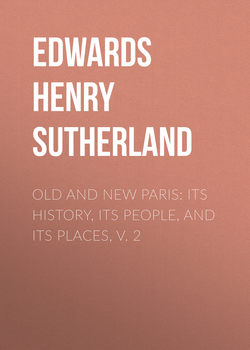Old and New Paris: Its History, Its People, and Its Places, v. 2

Реклама. ООО «ЛитРес», ИНН: 7719571260.
Оглавление
Edwards Henry Sutherland. Old and New Paris: Its History, Its People, and Its Places, v. 2
CHAPTER I. STREET CHARACTERS
CHAPTER II. THE ENGLISH AND AMERICANS IN PARIS
CHAPTER III. MORE PARISIAN TYPES
CHAPTER IV. THE DOMESTIC
CHAPTER V. PARISIAN CHARACTERISTICS
CHAPTER VI. THE STREETS
CHAPTER VII. THE SEINE AND ITS BRIDGES. – THE MORGUE
CHAPTER VIII. THE REFORMATION IN PARIS
CHAPTER IX. THE UNIVERSITY OF PARIS AND THE COLLEGE OF FRANCE
CHAPTER X. THE SORBONNE
CHAPTER XI. THE INSTITUTE
CHAPTER XII. THE ACADÉMIE FRANÇAISE
CHAPTER XIII. THE PANTHÉON
CHAPTER XIV. THE POLYTECHNIC SCHOOL
CHAPTER XV. THE HÔTEL CLUNY
CHAPTER XVI. THE MUSÉE D’ARTILLERIE
CHAPTER XVII. THE VAL DE GRÂCE – RELICS OF THE GREAT
CHAPTER XVIII. THE CATACOMBS: THE OBSERVATORY
CHAPTER XIX. THE ODÉON: THE LUXEMBURG PALACE
CHAPTER XX. THE PRISONS OF PARIS
CHAPTER XXI. THE PARIS ZOO
CHAPTER XXII. SOME HISTORICAL BUILDINGS
CHAPTER XXIII. THE MONT-DE-PIÉTÉ
CHAPTER XXIV. PARIS MARKETS
CHAPTER XXV. SAINT-GERMAIN-DES-PRÉS
CHAPTER XXVI. PRINTING IN PARIS – THE CENSORSHIP
CHAPTER XXVII. THE HÔTEL DES INVALIDES
CHAPTER XXVIII. SOME MORE PARIS HOSPITALS
CHAPTER XXIX. LUNATIC ASYLUMS AND MIXED INSTITUTIONS
CHAPTER XXX. THE RIVER BIÈVRE AND THE MANUFACTORY OF THE GOBELINS
CHAPTER XXXI. THE PALAIS BOURBON
CHAPTER XXXII. SOME HISTORICAL RESIDENCES
CHAPTER XXXIII. THE RUE TARANNE AND DIDEROT
CHAPTER XXXIV. MONSEIGNEUR AFFRE AND THE INSURRECTION OF JUNE
CHAPTER XXXV. SOME OCCUPANTS OF MONTPARNASSE
CHAPTER XXXVI. SPORTS AND DIVERSIONS
CHAPTER XXXVII. FENCING SCHOOLS
CHAPTER XXXVIII. PETTY TRADES
CHAPTER XXXIX. OBSOLETE PARIS SHOPS
CHAPTER XL. THE PARIS PRESS
CHAPTER XLI. FROM THE QUAI VOLTAIRE TO THE PANTHEON
CHAPTER XLII. THE PALAIS MAZARIN AND THE RUE MAZARINE
CHAPTER XLIII. THE PARIS RIVER AND PARIS COMMERCE
CHAPTER XLIV. THE BARRIERS – PARISIAN CRIME
CHAPTER XLV. PARISIAN MENDICANCY: THE PARIS POOR
CHAPTER XLVI. VERSAILLES
CHAPTER XLVII. VERSAILLES AND THE SIEGE OF PARIS
CHAPTER XLVIII. VERSAILLES AND THE COMMUNE
Отрывок из книги
HITHERTO the types of character which we have noticed have been native. Let us vary them by a glance at the typical foreigner or rather foreigners residing or sojourning in Paris.
To begin with the Englishman. In Paris, although there are a great number of Englishmen, it can hardly be said that an English Society exists. Samuel Johnson once complained that Englishmen did not fraternise with one another; that if two visitors called upon a lady about the same time and were shown into her drawing-room, they would, until the lady made her appearance – say for five minutes – simply glare at one other in silence, whereas a couple of foreigners would, although they had never met before, have entered into a conversation.
.....
In a general way the resident American population of Paris consists of the Diplomatic body, bankers, families who have come for the education of their children, and artists eager to study the masterpieces of the Parisian galleries. The American nation is accused of being devoid of artistic sentiment; but M. André Léo stoutly protests that “such a criticism passed upon a new people, who have been obliged to occupy themselves before everything with work and industry, is too hasty. American artists already exist; and already their efforts and their ambitions foretell the development of that noble and precious human faculty the germ of which exists in every people and every man, but which necessitates a certain leisure and a certain mental education.”
Apart from the American residing in Paris, and the American who, binding himself to the nation by more than lengthened residence, has married into some French family – an occurrence by no means rare – there is the flying American visitor to Paris, whose headquarters are the Grand Hotel on the Boulevard des Italiens. This establishment, by its central position, its interior arrangements, its luxury and its comfort, enjoys an enormous reputation on the other side of the Atlantic. The Yankee leaves New York for the Grand Hotel. It is not till he passes its threshold that he feels himself on terra firma again; it is here that he finds out where he is and gets his information. If his means or his projects permit it, he installs himself at this hotel for three or four months; if not, he goes on to some other hotel or boarding-house, or else rents an apartment to live by himself. If you enter the courtyard of the Grand Hotel, ascend the portico steps, and, making your way into the stately readingroom, look out of the window for five minutes, you will see that the innumerable vehicles which every few seconds stop at the hotel deposit ten Americans to one Englishman.
.....